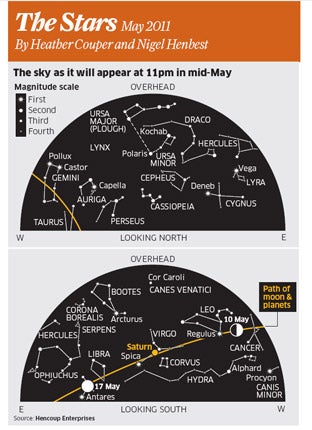The Stars: May 2011

The much-loved Plough is riding high in the heavens.
Its seven stars make up the "tail" and "stomach" of a larger constellation: Ursa Major (the Great Bear). Follow the Bear's tail south and you'll hit a brilliant star – Arcturus, whose orange colour tells us it is a cool star. Hot stars glow blue-white; average stars like our Sun shine yellow, with surface temperatures of 5000-6000C; Arcturus can only muster 4000C. It's a sure sign the star has become elderly.
What's Up
The bright "star" to the south is Saturn. Use a telescope to see Saturn in all its glory, with its magnificent rings and Titan, its biggest moon. Titan changes its position from night to night, looping twice around Saturn in May. Looking northwards, you'll find the Ursa Major almost overhead, its seven brightest stars making up the distinctive Plough. In North America, these stars are known as the Big Dipper; many British children today – who have little idea of what a plough looks like – call it the Saucepan.
The Plough is equally useful for locating an important celestial object. Imagine a line joining the end stars of the "saucepan" and extend away from the pan's base (see our chart). It leads straight to Polaris, the Pole Star. Polaris isn't particularly bright but it's important in helping us find directions, as it lies over the North Pole. So, wherever you are, the Pole Star is always due north.
Polaris lies at the tail-end of what looks like a mini-Plough. This is the constellation of Ursa Minor (the Little Bear), in Greek myth the son of the Great Bear. For those live across the Atlantic, these stars form the Little Dipper. The second-brightest star in the Little Bear, Kochab, is an orange giant, similar to Arcturus but farther away.
On the nights around 5 May, you may see incandescent fragments of Halley's Comet streaking across the sky. These shooting stars are specks of dust shed by the comet, burning up in Earth's atmosphere. They seem to spread out from Aquarius.
Diary
3: 7.51 am New Moon
5: Maximum of Eta Aquarid meteor shower
7: Mercury at greatest western elongation
10: 9.33 pm Moon at First Quarter
17: 12.09 pm Full Moon
24: 7.52 pm Moon at Last Quarter
Subscribe to Independent Premium to bookmark this article
Want to bookmark your favourite articles and stories to read or reference later? Start your Independent Premium subscription today.

Join our commenting forum
Join thought-provoking conversations, follow other Independent readers and see their replies